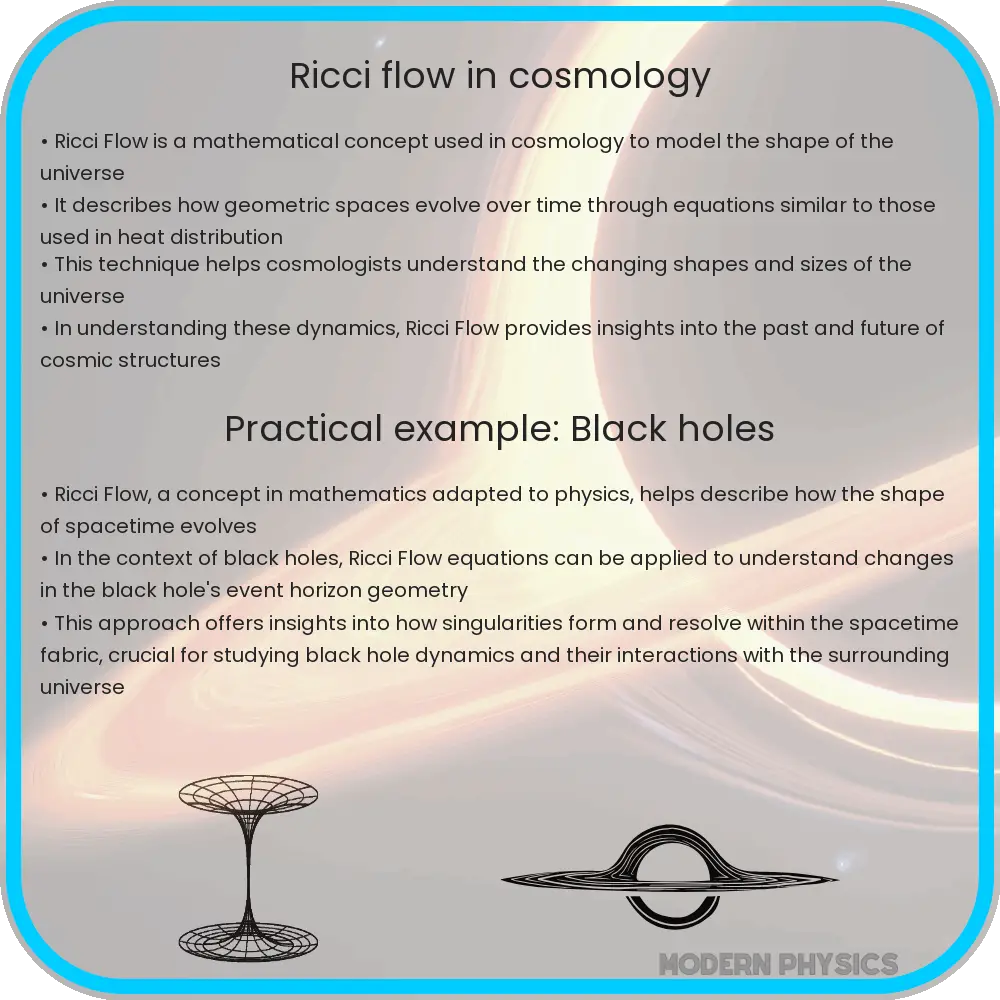Explore the role of Ricci Flow in cosmology: understanding universe evolution, geometry, and physics, and how it aids in resolving cosmic singularities and topology.

The Role of Ricci Flow in Understanding Cosmic Evolution
The intricate dance of mathematics and cosmology often unveils profound insights into the universe’s fabric and its evolutionary journey. One of the pivotal mathematical concepts that has found intriguing applications in cosmology is the Ricci Flow. Originally introduced by Richard S. Hamilton in the 1980s, Ricci Flow has emerged as a powerful tool in understanding the geometrical structure of space-time and its implications on the universe’s evolution.
Understanding Ricci Flow
Ricci Flow represents a process that systematically modifies the metric of a manifold, which can be thought of as a geometric space, in a way that distorts its shape. It is described by a partial differential equation that behaves somewhat like heat diffusion, smoothing out irregularities in the manifold’s curvature over time. In a cosmological context, this concept provides a framework for understanding how the geometry of the universe evolves and reshapes itself.
Implications in Cosmology
In cosmology, the shape and geometry of the universe are central to understanding its past, present, and future. The Ricci Flow helps physicists and mathematicians model the universe’s geometry, offering insights into the dynamics of its expansion and the distribution of matter and energy within it. By applying Ricci Flow techniques, researchers can theoretically trace the universe’s shape back to its origins, providing a clearer picture of the initial conditions that led to the Big Bang and subsequent cosmic evolution.
Connecting Geometry with Physics
The interaction between Ricci Flow and cosmology extends beyond mere geometry; it is deeply interwoven with the laws of physics. The curvature of space-time, dictated by Einstein’s General Relativity, influences the flow of time, the path of light, and the movement of celestial bodies. Ricci Flow offers a mathematical framework to explore these phenomena by examining how the universe’s geometric fabric evolves under the influence of its own curvature and mass-energy content.
This intersection of geometry and physics opens new avenues for understanding the fundamental nature of the universe and addressing some of the most perplexing questions in cosmology, such as the fate of cosmic singularities and the nature of dark matter and dark energy.
Exploring the Universe’s Topology with Ricci Flow
The utilization of Ricci Flow extends into the realm of topological studies, where it aids in categorizing the possible shapes and sizes of the universe. By analyzing the evolving shapes through Ricci Flow, scientists can infer the global topology of the universe, discerning whether it is open, closed, or flat. This is crucial for understanding the cosmic microwave background radiation and the overall fabric of cosmic structure.
Ricci Flow and the Resolution of Singularities
One of the most significant applications of Ricci Flow in cosmology is its potential to resolve singularities – points in space-time where physical laws break down, such as those at the center of black holes or the universe at the time of the Big Bang. Ricci Flow can smooth out these points, offering theoretical models in which the universe can be extended through these singular moments in a coherent, non-singular manner. This provides physicists with a more complete model of the universe’s lifecycle, from its inception to its ultimate fate.
Challenges and Future Directions
Despite its promising applications, Ricci Flow’s integration into cosmology is not without challenges. The mathematical complexity of Ricci Flow equations necessitates sophisticated computational techniques and assumptions that may oversimplify the universe’s complexities. Furthermore, translating these abstract mathematical concepts into observable predictions is an ongoing challenge for cosmologists.
Future research aims to refine these models, improve computational methods, and develop more direct connections between Ricci Flow mathematics and astronomical observations. This will help scientists to validate the theoretical models and understand the practical implications of Ricci Flow on the universe’s structure and evolution.
Conclusion
The interplay between Ricci Flow and cosmology represents a fascinating fusion of mathematics and physics, offering a unique lens through which to view the universe’s grand tapestry. By bridging the gap between abstract mathematical concepts and the tangible realities of the cosmos, Ricci Flow helps to unravel the mysteries of the universe’s geometry, evolution, and ultimate destiny. As research progresses, the potential of Ricci Flow to illuminate the darkest corners of our universe continues to expand, promising new insights into the cosmic puzzle that has perplexed humanity for millennia.
